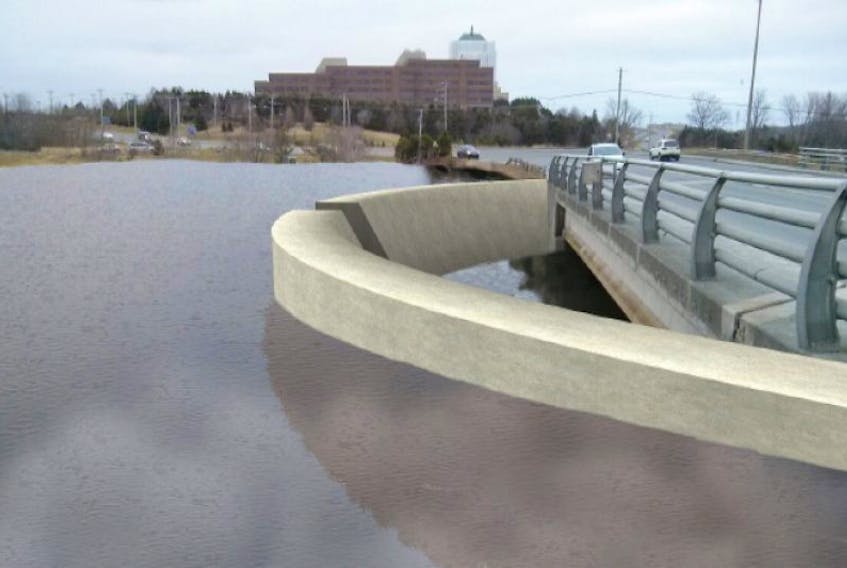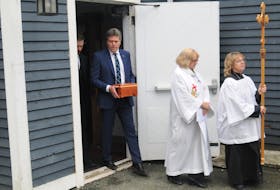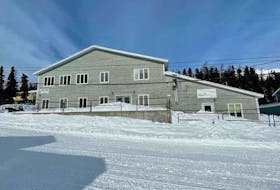
The system cuts across a large portion of the capital city. The watershed includes Yellow Marsh Stream, Ken Brook, Leary’s Brook and Rennie’s River, discharging into Quidi Vidi Lake.
It’s prone to flooding.
“Flooding has, at a minimum, been inconvenient for the residents of the city of St. John’s and, at other times, has resulted in major public and private property damage,” summarized a city consultant in 2014.
The report came on the heels of flooding at points along the system in 2001, 2004, 2005, 2008 and 2010 — the latter being when hurricane Igor dumped 200 millimetres of rain on the city, filling points from the Health Sciences Centre to Fieldian Grounds soccer pitch off Portugal Cove Road.
Consultant CBCL made recommendations for infrastructure that could be added to help avoid damage and roadblocks in future weather events. The ideas included berms (barriers) at points along the river system, as well as a weir at Long Pond in Pippy Park — an installation allowing for retention of water and slower release downstream.
City council has been unable to get projects completed to date.
Working on weir
Coun. Sandy Hickman worked on the follow-up. He confirmed construction plans along the system have been hung up on the recommended Long Pond project. He said he feels frustrated with the lack of progress.
However, he said there are many stakeholders along the extensive river system, all with concerns needing to be addressed.
“We’ve been very lucky since,” he said of the heavy rain events in the last few years.
City public works committee chair Coun. Danny Breen also sits with the Pippy Park Commission. He said the commission has not approved of the design for the weir at Long Pond.
RELATED STORIES:
O’Leary Avenue bridge to be replaced in 2017
Flood control measures approved by council for Rennie’s River
A project plan including preliminary design was put to environmental assessment with the province, but the province ultimately demanded more information.
Breen and Hickman both said the concept could not obtain approval from the park commission as well.
A message left for the commission was not returned.
“It’s esthetically not appealing, which is probably the biggest issue,” Breen said of the weir proposed. “Plus, there’s some concern about the impact it will have on the trails and that.”
The retention of water in the pond would raise the pond’s water level in heavy rains. Apart from the park commission, NatureNL members have raised red flags on what the sudden change might mean for the pond-area ecosystem.
“It’s kind of stalled,” Breen said. “So what we’ve done is our staff have looked at another option.”
The idea now is to propose a similar means of holding back water, but to be installed further along, on the other side of Allandale Road, where water runs toward the Confederation Building.
Consultants are working on new models, with some preliminary design expected for review near the end of July.
But if any of the recommended construction was to save properties, the city’s consultant also made the process clear: “Without the weir on Long Pond the recommended downstream improvements do not work. The walls and berms at those locations would have to be so large/high that they become impractical. Since there is limited space in the downstream reach to construct flood control structures, it is necessary to reduce the peak flow by the use of the weir. Therefore, the weir must be constructed prior to the downstream improvements being implemented.”
New project emerges
While the City of St. John’s is still working toward some kind of work on the river system, a new project has been proposed for along the river by Eastern Health, based at least in part on the same consultant’s report.
The Eastern Health proposal is for a berm, to help keep anticipated water from Leary’s Brook and Leary’s Brook Pond from moving toward the hospital building. No one from Eastern Health was available for an interview about the project, but a statement was issued in response to questions.
“Historically a berm has always been in place at the Health Sciences Centre and is a necessary structure to ensure the protection of the facility during flooding. Recommendations from recent studies, such as the Rennie’s River Catchment Stormwater Management Plan, identified the need for the berm to be larger due to the increase in flood plain levels,” it stated.
“The organization will be moving forward, once all environmental approvals are in place, to install this berm in efforts to ensure uninterrupted access to health care services in the event of a possible external event.”
If a hard rain is going to fall, they don’t want a flood at their property from the river.
The climate change clock
Breen said part of the problem faced by the city is that there is an expectation for heavier rain events, putting demand on the infrastructure dollar and timeline.
“If you take the combination of the development that’s happened and the impact of climate change, then it’s kind of all coming together to ensure that we’re putting a lot of our capital money into the infrastructure and upgrading when we do it,” he said.
Increased requirements for storm-water detention (such as retaining ponds) to be included in developments has helped, he suggested. However, the weather is beyond city control.
“The storms that we’re getting are becoming more frequent and heavier. It’s not only the volume of water. It’s the rate at which the water moves. … To not improve the infrastructure to accommodate the impacts of climate change is just not prudent.”
The city had already installed a weir at Quidi Vidi Lake. And in 2013, a $2.4-million project was completed involving the bridge on Carnell Drive, adding capacity to carry water between Rennie’s Mill River and the lake.
Breen noted a more recent project — the $1.17-million O’Leary Avenue bridge upgrade, near the Avalon Mall, behind the Dollarama. It’s a partnership with mall property owner Crombie REIT and will include infrastructure upgrades to carry more storm-water.
The team-up means the project pushed ahead in the capital works schedule, allowing the mall owners to move ahead with their own planned upgrades, with the city getting the benefit of up to $425,000 contributed to the project’s cost.









